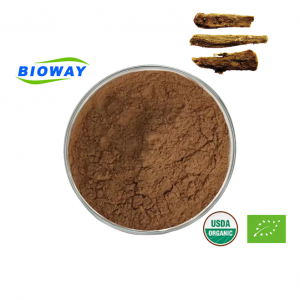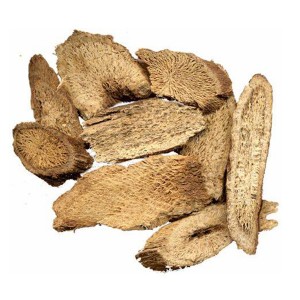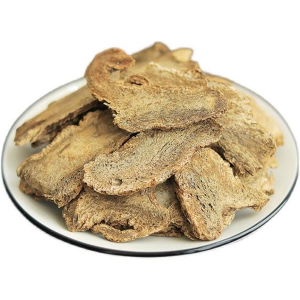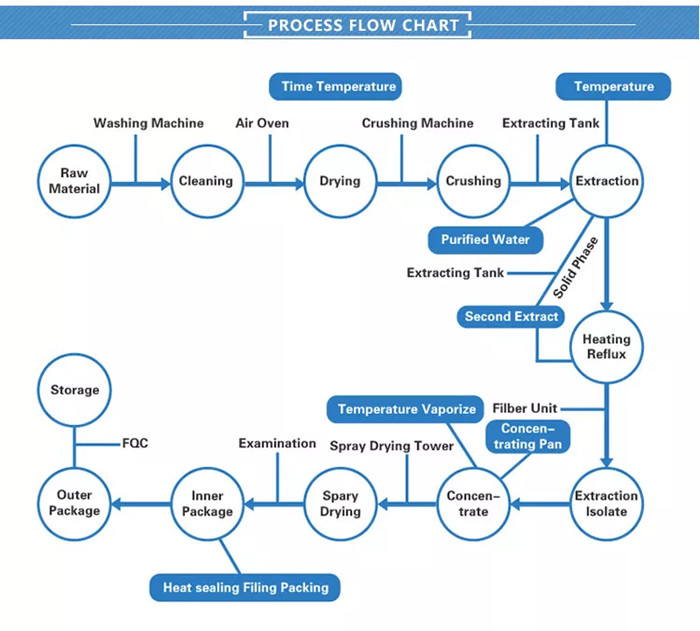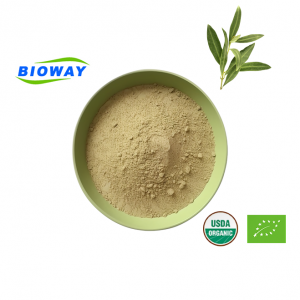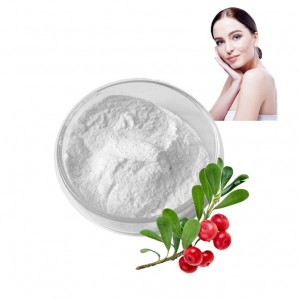Aucklandia Lappa Root Extract
In traditional Chinese medicine, Aucklandia lappa root extract, or Chinese Saussurea Costus Root Extract, also known as Yun Mu Xiang and Radix Aucklandia, is an herbal extract derived from the roots of the Aucklandia lappa Decne.
With the Latin Name of Aucklandia lappa Decne., it also has many other common names, such as Saussurea lappa Clarke, Dolomiaea costus, formerly known as Saussurea costus, costus, Indian costus, kuth, or putchuk, Aucklandia costus Falc.
This extract is used in traditional Chinese medicine to help with gastrointestinal issues. It's also known as Mok-hyang in Korea. The root contains sesquiterpenes, which can help relieve gastrointestinal problems. Aucklandia lappa extract can be prepared as a powder, decoction, or pill, and can be mixed with oil for topical use on muscles and joints. It is believed to have functions related to regulating Qi (vital energy) in the body, alleviating digestive discomfort, and addressing symptoms associated with stagnation in the gastrointestinal system. The extract contains various bioactive compounds, including volatile oils, sesquiterpenes, and other phytochemicals, which are responsible for its potential health benefits. It is often used in traditional herbal formulations to support digestive health and address related issues.
| Main Active Ingredients | English Name | CAS No. | Molecular Weight | Molecular Formula |
| O-4-甲基香豆素-N-[3-(三乙氧基硅基)丙基]氨基甲酸盐 | 5α-Hydroxycostic acid | 132185-83-2 | 250.33 | C15H22O3 |
| β-酒石酸 | beta-Costic acid | 3650-43-9 | 234.33 | C15H22O2 |
| 环氧木香内酯 | Epoxymicheliolide | 1343403-10-0 | 264.32 | C15H20O4 |
| 异土木香内酯 | Isoalantolactone | 470-17-7 | 232.32 | C15H20O2 |
| 土木香内酯 | Alantolactone | 546-43-0 | 232.32 | C15H20O2 |
| 乌心石内酯 | Micheliolide | 68370-47-8 | 248.32 | C15H20O3 |
| 木香烃内酯 | Costunlide | 553-21-9 | 232.32 | C15H20O2 |
| 去氢木香内酯 | Dehydrocostus Lactone | 477-43-0 | 230.3 | C15H18O2 |
| 白桦脂醇 | Betulin | 473-98-3 | 442.72 | C30H50O2 |
Aucklandia lappa root extract is associated with several potential features and functions:
1. Digestive Support: Aucklandia lappa root extract is traditionally used to support digestive health. It is believed to have properties that can help alleviate symptoms such as abdominal discomfort, bloating, and indigestion.
2. Qi Regulation: In traditional Chinese medicine, Mu Xiang is valued for its potential to regulate the flow of Qi (vital energy) in the body. It is used to address symptoms related to Qi stagnation, which can manifest as various digestive issues.
3. Anti-inflammatory Potential: Some studies suggest that compounds found in Aucklandia lappa root extract may have anti-inflammatory properties, which could be beneficial for addressing certain inflammatory conditions.
4. Gastrointestinal Regulation: The extract may have effects on gastrointestinal motility, potentially helping to regulate intestinal contractions and alleviate spasms.
5. Traditional Medicinal Use: Aucklandia lappa root extract has a long history of use in traditional herbal formulations, particularly in East Asian traditional medicine systems, for its potential therapeutic effects on the digestive system.
Aucklandia lappa root extract has various potential applications, including:
1. Traditional Medicine: Used in traditional herbal medicine systems, particularly in East Asian traditional medicine, for its potential digestive support and regulatory properties.
2. Digestive Health Supplements: Formulated into dietary supplements to support digestive health and alleviate symptoms such as bloating, indigestion, and abdominal discomfort.
3. Herbal Formulations: Incorporated into traditional herbal formulations to address symptoms related to Qi stagnation and gastrointestinal issues.
4. Research and Development: Used in scientific research to explore its bioactive compounds and potential health benefits, including its anti-inflammatory and gastrointestinal regulatory properties.
5. Traditional Remedies: Employed into traditional remedies for addressing digestive discomfort, promoting healthy digestion, and supporting overall gastrointestinal well-being.
Aucklandia lappa Decne is a commonly used Chinese medicinal material, its main ingredients include volatile oils, lactones and other ingredients. Among them, volatile oils account for 0.3% to 3%, mainly including monotaxene, α-ionone, β-aperygne, phellandrene, costylic acid, costinol, α-costane, β-costane Hydrocarbons, costene lactone, camphene, etc. The main components of lactones include 12-methoxydihydrodehydrocostunolactone, isodehydrocostunolactone, α-cyclocostunolide, β-cyclocostunolide, and alanolactone , isoalanolide, linolide, etc. In addition, costus also contains stigmasterol, stigmasterol inulin, costus alkaloids, betulin, resin, and other ingredients.
Pharmacological effects:
costus has certain effects on the digestive system, including excitatory and inhibitory effects on the intestines, as well as effects on intestinal muscle tone and peristalsis. In addition, costus also has certain effects on the respiratory and cardiovascular systems, including dilation of the trachea and bronchi, and effects on cardiac activity. In addition, Aucklandia lappa Decne also has certain antibacterial effects.
The theory of traditional Chinese medicine:
The nature and flavor of Acosta are pungent, bitter, and warm, and it belongs to the spleen, stomach, large intestine, triple burner, and gallbladder meridian. Its main therapeutic functions include promoting qi and relieving pain, invigorating the spleen and eliminating food, and is used for symptoms such as distension and pain in the chest and flanks, epigastrium and abdomen, severe diarrhea, indigestion, and inability to eat. Costus can be used to simmer the intestinal tract to stop diarrhea and treat symptoms such as diarrhea and abdominal pain.
The usage and dosage:
Aucklandia lappa Decne is generally 3 to 6g. It should be placed in a dry place to avoid moisture when stored.
The active ingredients found in Aucklandia costus or Chinese Saussurea Costus Root Extract have been studied for their potential pharmacological properties. Here’s a comprehensive analysis of some of these compounds:
5α-Hydroxycostic acid and beta-Costic acid: These are triterpenoids that have been investigated for their anti-inflammatory and antioxidant properties. They may have potential applications in the treatment of inflammatory conditions.
Epoxymicheliolide, Isoalantolactone, Alantolactone, and Micheliolide: These compounds belong to the class of sesquiterpene lactones and have been studied for their anti-inflammatory, anti-cancer, and immunomodulatory effects. They are known for their potential to modulate immune responses and inhibit inflammatory pathways.
Costunolide and Dehydrocostus Lactone: These sesquiterpene lactones have been researched for their anti-inflammatory, anti-cancer, and anti-microbial properties. They have shown potential in modulating immune responses and inhibiting the growth of cancer cells.
Betulin: This triterpenoid has been studied for its diverse pharmacological activities, including anti-inflammatory, anti-cancer, anti-microbial, and hepatoprotective effects. It has shown potential in various preclinical studies for its therapeutic properties.
These active ingredients collectively contribute to the potential medicinal properties of Aucklandia costus or Chinese Saussurea Costus Root Extract. It’s important to note that while these compounds have shown promise in preclinical studies, further research is needed to fully understand their pharmacological effects and potential therapeutic applications. Additionally, the effects of these compounds can vary based on factors such as dosage, formulation, and individual health conditions. Always consult with a qualified healthcare professional before using any herbal extract for medicinal purposes.
Packaging And Service
Packaging
* Delivery Time: Around 3-5 workdays after your payment.
* Package: In fiber drums with two plastic bags inside.
* Net Weight: 25kgs/drum,Gross Weight: 28kgs/Drum
* Drum Size & Volume: I.D.42cm × H52cm, 0.08 m³/ Drum
* Storage: Stored in a dry and cool place, keep away from strong light and heat.
* Shelf Life: Two years when properly stored.
Shipping
* DHL Express, FEDEX, and EMS for quantities less than 50KG, usually called as DDU service.
* Sea shipping for quantities over 500 kg; and air shipping is available for 50 kg above.
* For high-value products, please select air shipping and DHL express for safety.
* Please confirm if you can make the clearance when goods reach your customs before placing an order. For buyers from Mexico, Turkey, Italy, Romania, Russia, and other remote areas.
Payment And Delivery Methods
Express
Under 100kg, 3-5 Days
Door to door service easy to pick up the goods
By Sea
Over300kg, Around 30 Days
Port to port service professional clearance broker needed
By Air
100kg-1000kg, 5-7 Days
Airport to airport service professional clearance broker needed
Production Details (Flow Chart)
1. Sourcing and Harvesting
2. Extraction
3. Concentration and Purification
4. Drying
5. Standardization
6. Quality Control
7. Packaging 8. Distribution
Certification
It is certified by ISO, HALAL, and KOSHER certificates.






